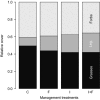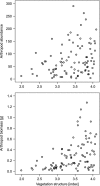Experimental evidence for the immediate impact of fertilization and irrigation upon the plant and invertebrate communities of mountain grasslands
- PMID: 25360290
- PMCID: PMC4203302
- DOI: 10.1002/ece3.1118
Experimental evidence for the immediate impact of fertilization and irrigation upon the plant and invertebrate communities of mountain grasslands
Abstract
The response of montane and subalpine hay meadow plant and arthropod communities to the application of liquid manure and aerial irrigation - two novel, rapidly spreading management practices - remains poorly understood, which hampers the formulation of best practice management recommendations for both hay production and biodiversity preservation. In these nutrient-poor mountain grasslands, a moderate management regime could enhance overall conditions for biodiversity. This study experimentally assessed, at the site scale, among low-input montane and subalpine meadows, the short-term effects (1 year) of a moderate intensification (slurry fertilization: 26.7-53.3 kg N·ha(-1)·year(-1); irrigation with sprinklers: 20 mm·week(-1); singly or combined together) on plant species richness, vegetation structure, hay production, and arthropod abundance and biomass in the inner European Alps (Valais, SW Switzerland). Results show that (1) montane and subalpine hay meadow ecological communities respond very rapidly to an intensification of management practices; (2) on a short-term basis, a moderate intensification of very low-input hay meadows has positive effects on plant species richness, vegetation structure, hay production, and arthropod abundance and biomass; (3) vegetation structure is likely to be the key factor limiting arthropod abundance and biomass. Our ongoing experiments will in the longer term identify which level of management intensity achieves an optimal balance between biodiversity and hay production.
Keywords: Agriculture; arthropods; grassland management; hump-shaped model; liquid manure; vegetation heterogeneity.
Figures




References
-
- Baayen RH. 2011. languageR: Data sets and functions with “Analyzing Linguistic Data: A practical introduction to statistics”. R package version 1.4.
-
- Bates D, Maechler M, Bolker B. 2011. lme4: Linear mixed-effects models using S4 classes. R package version 0.999375-42.
-
- Bernhardt-Romermann M, Romermann C, Sperlich S, Schmidt W. Explaining grassland biomass - the contribution of climate, species and functional diversity depends on fertilization and mowing frequency. J. Appl. Ecol. 2011;48:1088–1097.
-
- Bowman WD, Gartner JR, Holland K, Wiedermann M. Nitrogen critical loads for alpine vegetation and terrestrial ecosystem response: are we there yet? Ecol. Appl. 2006;16:1183–1193. - PubMed
-
- Britschgi A, Spaar R, Arlettaz R. Impact of grassland farming intensification on the breeding ecology of an indicator insectivorous passerine, the Whinchat Saxicola rubetra: lessons for overall Alpine meadowland management. Biol. Conserv. 2006;130:193–205.
LinkOut - more resources
Full Text Sources
Other Literature Sources
Research Materials

